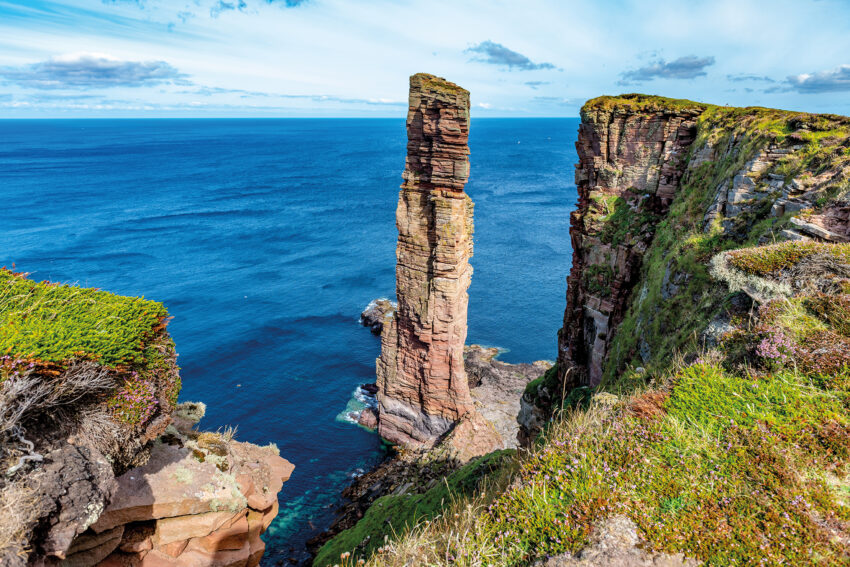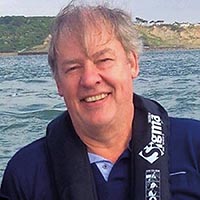
The Stunning Coastline of the Orkneys Above Scotland
North of mainland Scotland is the archipelago of Orkney. Apart from stunning coastal scenery and a wide variety of wildlife, the islands have a history going back 5,000 years to the Neolithic Stone Age and have abundant evidence of Viking settlements dating from the ninth century.
This is just one of the coastlines that Peter Firstbrook explores and explains in his book Coastwise: Understanding Britain’s Shoreline. The book is a multifaceted story that involves ancient geology and powerful ocean forces, combined with the interaction of unique plants, animals and other organisms and the impact of humans from the earliest times to the modern day.
The author seeks to excite, inspire and highlight the links between geology, oceanography (Part One), and biology (Part Two) with field guides on those interested to learn more. Part Three looks at how the coast has shaped human history and how we have shaped the coast, and Part Four is a guide to where you can find and experience some of the features covered in the book.
There are hundreds of stunning photos and illustrations, making the book essential reading for all those who spend time on the coast. Here we are going to look at it with a visit to the Orkney Islands.
Excerpt from Coastwise – Understanding the Orkneys and Britain’s Shoreline
Rackwick Bay on the Island of Hoy in the Orkney Islands is one of the most remote and ruggedly beautiful parts of the British Isles. The beach here is a mixture of fine sand and large boulders and provides a home to a variety of plants and birds that survive on a very exposed site, facing 3,500km (2,175 miles) of open Atlantic Ocean.
From the beach you can look up at St John’s Head, 335m (1,128ft) high and the tallest vertical sea cliff in Britain; nearby is the Old Man of Hoy, the tallest sea stack in the country.

The cliffs here are made from Old Red Sandstone laid down 370 million years ago in a dry desert, long before dinosaurs roamed the Earth. Gales blow for more than 30 days a year, creating high-energy waves which roll in from the North Atlantic. These ancient cliffs are no match for the pounding they receive from the ocean, and the fascinating story of the Old Man of Hoy offers a poignant example of how even the most resilient parts of our coastline can change over the years.
Less than 300 years ago there was a narrow headland here at Rackwick, but no sea stack. The cliffs were subsequently eroded by waves, and by 1817 there was a ‘two-legged’ Old Man of Hoy; we know this from an aquatint by William Daniell (1769-1837), an English landscape and marine painter. Daniell’s painting shows a wave-cut notch at the base of the stack, and erosion here at sea level continued to undermine the structure.
Wave erosion won out, and sometime in the last hundred years, the seaward part of the Old Man collapsed, leaving only a single sea stack; the whole edifice is expected to collapse completely at any time, and nothing more than a rock stump will remain.
The beach at Rackwick Bay shows what happens to solid rock when it is subjected to marine erosion, and the foreshore comprises sediments ranging from fine sand to very large boulders up to 1m (3.3ft) across. Most of this material has fallen from the cliffs as they were eroded, and the beach is the result of millennia of erosion and weathering.
In time, the cobbles and boulders will be broken down further and carried away by waves and currents, to be deposited along other parts of the coastline, possibly hundreds of kilometers away.

More Features to Discover in the Orkneys
Brough of Birsay, mainland Orkney
The uninhabited island is accessible on foot at low tide along a largely natural causeway, which is flooded at high tide. Historic site (Picts, Viking, late Medieval): Rings and brooches found on the island suggest it was a Pictish power center; later evidence of Viking houses and even a sauna.
Island of Hoy
Birdwatching, Nature Reserve: Expect to see fulmars, puffins, red-throated divers, great skuas, hen harriers, stonechats and many more.
Dingieshowe Bay (Deerness island), mainland Orkney
‘Tombolo’ sandbar, a natural feature that connects the former island of Deerness to the mainland, and you can now drive across it on the A960.
Hill of White Hamars, South Walls
Seals and birdwatching: Watch seals swimming offshore and cliff-nesting seabirds on a range of coastal features, including cliffs, caves, arches and stacks.
Pentland Firth and Orkney
Orcas, minke whales, and migrating cetaceans pass through the straits between mainland Scotland and Orkney Islands and can be seen from headlands and bays in calm seas.
Skara Brae, Sandwick

Historic site (pre-history): A Stone Age settlement on the Bay of Skaill, on the west coast of the mainland, with houses that include stone hearths, cupboards, and beds.
Maeshowe, mainland Orkney
Historic site (pre-history): This Stone Age chambered cairn and passage grave probably dates from around 2,800BC, and was built from huge sandstone blocks.
Kirkwall
A natural harbor said to be Orkney’s best-preserved Viking town; it now serves fishing, yachts, and cruise ships.
Scapa Flow
Another natural harbor and historic site: This deep-water harbor was an anchorage for Viking longboats; it was a major naval base during the First and Second World Wars.
Hackness Martello Tower & Battery, South Walls
Historic site (modern era): These well-preserved military defenses were built during the Napoleonic Wars, but never saw action; open to the public.
About Peter Firstbrook

Peter Firstbrook studied oceanography and geography at university before spending five years in post-graduate research. He worked for the BBC for 25 years and was a member of the 1999 expedition that discovered climber George Mallory’s body on Mount Everest.
Lost on Everest (winner of the Trento Mountain Book Festival award) is his account of this and is a marvelous blend of adventure, history, geopolitics and biography.
He is the author of six books in total which includes The Obamas (the history of Barack Obama’s roots back to Kenya), and of course Coastwise in which he uses his oceanography background to enable us to appreciate how the powerful forces of nature and human activity have come together to create a coastline that we can visit and enjoy today.
If you are in the USA, you can also buy direct from Casemate IPM here Anywhere else in the world, you can buy direct from Fernhurst Books here
© Fernhurst Books.
- Camino Tales: Wine and Memories in Galicia, Spain - July 25, 2024
- Beluga Hunting in Norway - July 20, 2024
- Costa Rica: A Rainforest Chocolate Tour - July 18, 2024

